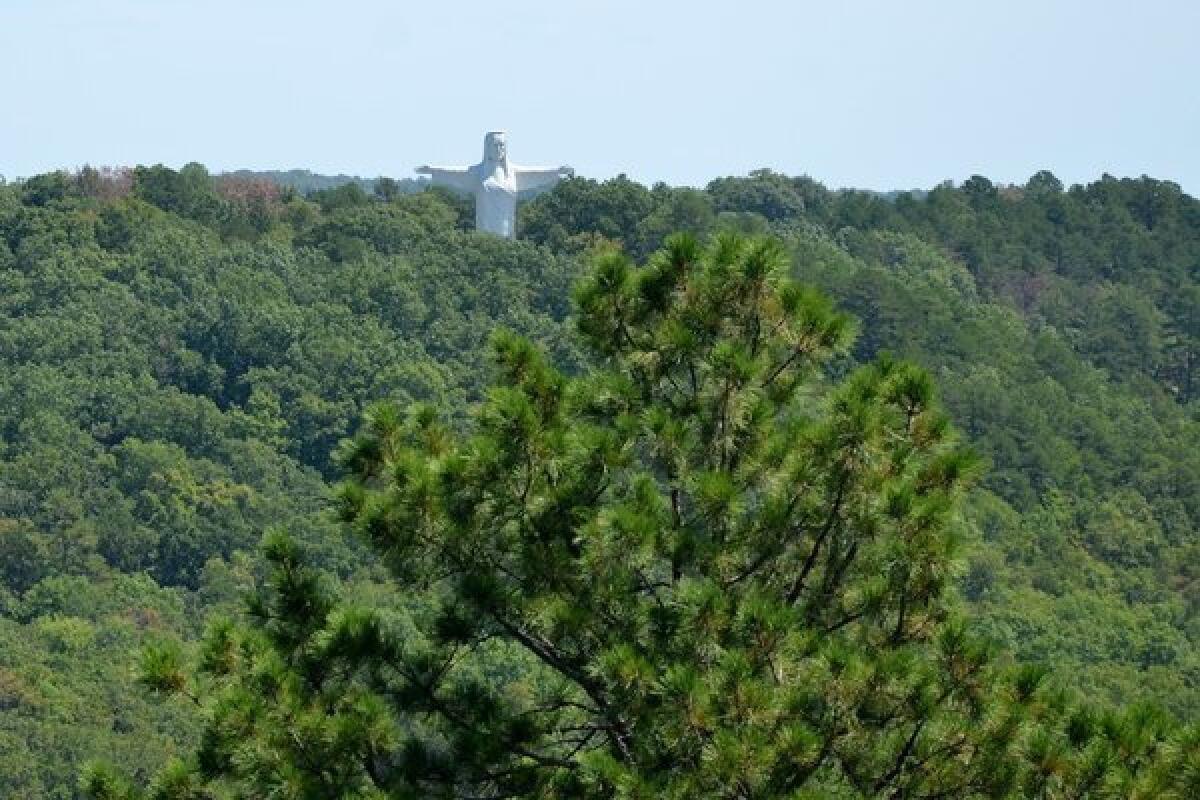In Arkansas, the Ozarks-Razorbacks-Chuck Mangione connection

- Share via
A few weeks ago, I was up in the northwest corner of Arkansas, roaming some Ozarks highways and nosing around Eureka Springs and Fayetteville, home of the University of Arkansas Razorbacks. The territory was generally handsome — and it’s probably got fall color coming on any day now — but three stops stood out.
— Thorncrown Chapel. From Northwest Arkansas Regional Airport in Bentonville, make the 50-mile eastbound drive into the Ozarks on Highway 62, past the Pea Ridge National Military Park (where North beat South in a crucial Civil War battle), past Beaver Lake, to the easy-to-miss turnoff for Thorncrown Chapel.
Thorncrown, completed in 1980, is the masterwork of Arkansas architect E. Fay Jones, a fixture on architects’ lists of America’s “best” buildings. Thorncrown, a 48-foot-high glass tower, stands on a steep slope, surrounded by oak, hickory and dogwood, supported by a mostly pine frame and trusses in diamond patterns. Light filters softly through the trees, windows and trusses, and on the day I visited, somebody had the good sense to ask music director Patricia Taylor for a song or two. She played “How Great Thou Art” on the chapel piano and sang “In the Sweet Bye and Bye” a capella, so that the chapel seemed filled with nothing but sunbeams and one high, pure voice.
— Eureka Springs. Another mile and a half beyond the chapel stands the 19th century town of Eureka Springs, which was born as a resort getaway. Nowadays it’s a tourist haven of shops and galleries, heavy on the hippie influences, all wedged into Victorian buildings that are practically carved into the steep slopes.
Atop the hill stands the Crescent Hotel, and from its Sky Bar, you can just see the Christ of the Ozarks, a seven-story-high white concrete sculpture of Jesus that goes back to 1966. Website RoadsideAmerica.com (a fine source on all that is highway-adjacent and kitschy in America) says that some people think the sculpture looks like Willie Nelson in a dress. Not so. It’s much more Chuck Mangione, circa 1977.
— Fayetteville. Maybe you don’t need any more irreverence after the Chuck Mangione thing, but I thought I did. So I headed south to Fayetteville, home to the University of Arkansas and its 24,000 students, about 30 miles below Bentonville. I got the full student vibe on West Dickson Street — live bands, karaoke bars, restaurants, a condom shop, the revelry-adjacent Dickson Street Inn, the almost endless Dickson Street Bookshop (all used) and the Walton Arts Center, which includes a 11,200-seat proscenium stage and two black-box spaces.
On campus a few blocks away, I circled the 1879 Old Main building (the oldest on campus) and inspected the well-renovated Inn at Carnall Hall, which was built as a women’s residence hall in 1905 but now serves as an upscale hotel. (I’m pretty sure nobody’s ever made a joke about its name.) Next time I’m in Fayetteville, I’ll probably stay there, although the Chancellor, a new and even fancier hotel full of enticements for the business traveler, opened in September just off the square where the big Saturday-morning farmers market happens.
The reason for my trip, by the way, was research on Bentonville, about 30 miles north of Fayetteville, where Wal-Mart heiress Alice Walton has bankrolled the Crystal Bridges Museum of American Art (open since 11/11/11). We’ll have that story soon.
Follow us on Twitter @latimestravel
Like us on Facebook @Los Angeles Times Travel
More to Read
Sign up for The Wild
We’ll help you find the best places to hike, bike and run, as well as the perfect silent spots for meditation and yoga.
You may occasionally receive promotional content from the Los Angeles Times.






